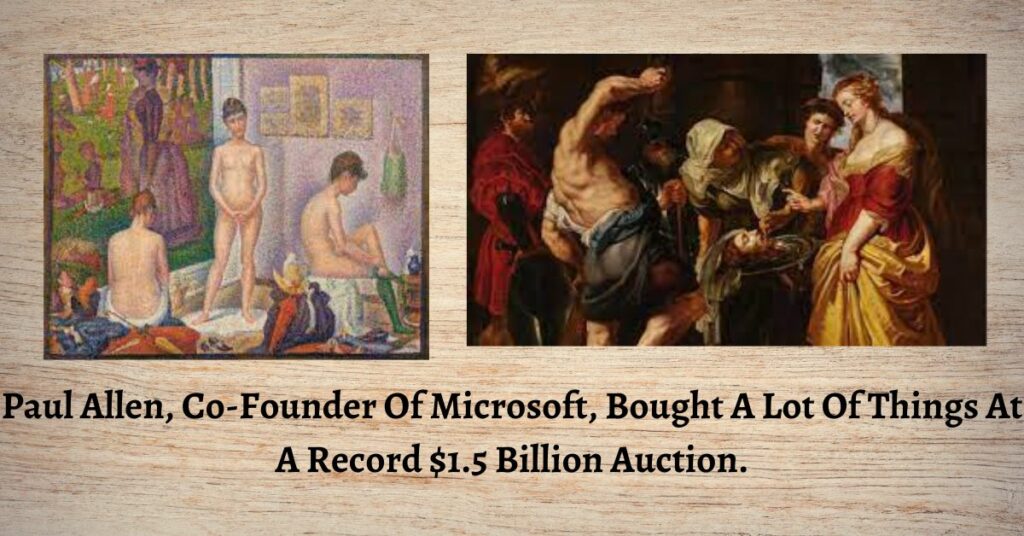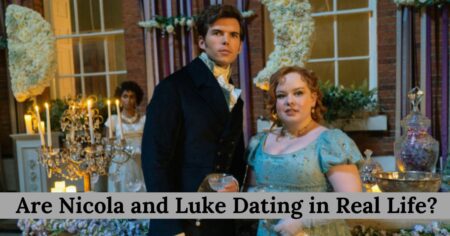As the first 60 pieces from the collection of the late Microsoft co-founder Paul Allen sold for $1.3 billion ($1.5 billion plus fees), Christie’s New York auction records fell on Wednesday night. It was the first auction haul to surpass $1 billion and the largest single auction haul in history. In another auction first, three pieces hammered for more than $100 million, and five when the auction house’s premium was added.
You can also check
- Artwork By Microsoft Co-Founder To Fetch $1 Billion
- Rosy Guidance: Microsoft Misses Estimates But Stock Up 5%
All but one item hammered above $1 million; the cheapest was a 1922 oil by Paul Klee at $850,000 ($1.1 million with fees). The most expensive lot was Georges Seurat’s “Les Poseuses, Ensemble (Petite version),” which was purchased over the phone by Christie’s vice chair and liaison to Chinese billionaires Xin Li-Cohen for an artist record price of $130 million ($149.2 million). High-powered art consultants were the main buyers in the crowded saleroom, selecting pieces for their wealthiest clientele. On the whole, 20 artist records were created that evening.
The top-of-the-line auction on Wednesday surpasses the likes of Peggy and David Rockefeller, whose collection brought in $835.1 million including fees in 2018. A large portion of the Paul Allen auction’s excitement was inevitable. Presale estimates had been established at a minimum of $1.1 billion, and Christie’s had pledged to purchase every item. As a result, 39 of the 60 works have since been supported by third parties who have made buy-at-least commitments.
The enormous sums will nevertheless boost a market’s confidence as it continues to appear to defy the ongoing economic and political unrest outside of its bubble. The artwork in Christie’s sales, which by no means represents Allen’s whole collection, provides a picture of him as a haphazard collector. The Microsoft CEO, who passed away in 2018 at the age of 65, avidly collected a variety of artists rather than favoring any particular genre or era. His emotional tendencies are noted in Christie’s catalog, which also mentions a fondness for Venice, where Allen’s yacht was frequently observed.
On Wednesday, he sold two Canalettos, one from around 1730 that brought $8.8 million ($10.5 million with fees, est. $5 million–$7 million), and another from a little later period that reached $10 million ($11.8 million with fees, est. $2.5 million–$3.5 million). Le Grand Canal à Venise, an uncharacteristically bright 1874 painting by Manet, sold for $45 million ($51.9 million with fees, est $45 million–$65 million),
while Giacometti’s 1958 sculpture “Femme de Venise III” brought in an above-estimate $21.5 million ($25 million with fees). The revelation of Allen’s supremacy in London and New York auction rooms during the latter 20 years of his life is the most startling. He reportedly made direct purchases and frequently selected many works from a sale. He purchased three paintings from a Christie’s auction in London on December 8, 1999.
These had good sales: Paul Klee’s “Bunte Landschaft” (1928), purchased by Allen for £991,500, sold on Wednesday for $4 million ($4.9 million with fees, est. $1.2 million to $1.8 million); Yves Tanguy’s “Un grand tableau qui représente un paysage” (1927), purchased for £1.5 million, a record for the artist at the time, sold on Wednesday for $2.8 million ($3.4 million with fees, est. $2.5 million to $3.5 million); and Francis Bacon’s “
A different World Cup trophy will be created by artist Andrei Molodkin on behalf of the Spanish football journal Libero in order to draw attention to the human rights abuses occurring in Qatar, the oil-rich nation hosting this year’s contentious competition, which gets underway on November 20. The $150 million life-size acrylic mould created by Molodkin out of a fake trophy will be filled gradually with crude oil.
The creator claims that this cost corresponds to the earnings from “bribes and kickbacks” received by former Fifa officials, as revealed by the US Department of Justice in 2015. The artist claims that the sale’s proceeds will support Amnesty International’s calls for compensation for migrant workers who have experienced human rights violations while working on the 2022 World Cup.
According to Molodkin, “I have always been fascinated in significant icons that have been tainted by the by-products of war and warfare.” A depiction of Russian President Vladimir Putin created in a recent piece by the artist, who was born in Russia, served in the army, and is currently based in France, is filled with blood from Ukrainian soldiers.
On December 18, the day of the tournament’s final, his “World Cup Filled with Qatari Oil” (2022) is scheduled to be displayed in London’s newly opened Kennington space of the activist group A/political. The Shanghai-based Photofairs will debut an edition in New York City in 2019.
The Armory Show, a modern and contemporary art show, will coexist with the fair for up to 100 galleries in the Javits Center on Manhattan’s West Side (September 8-10). According to Scott Gray, founder, and CEO of Creo (formerly the World Photography Organisation), a collaboration with Angus Montgomery Arts, “It’s already a fantastic time of year to be in New York, and we are adding flavor to that week.”
You can also check
- Microsoft Surface Laptop 5: Release Date Status, Specs and Everything we know so far
- U.S. Summer Market Surge At Jeopardy As September Approaches: Wall Street Week
In 2017, Photofairs held two editions in San Francisco as a test run for the US market. Since then, collectors and institutions have shown a growing interest in photography while, as Gray points out, the medium itself has broadened its meaning. Along with more conventional modern to contemporary fare, the new event will feature separate sections for film and video art.
“Today’s artists hardly ever categorize themselves as being only photographers. The environment that surrounds modern photography has expanded greatly. Whatever your opinion of NFTs, Gray asserts that they have aided in attracting the market for digital art. The founders and directors of Photo London, Michael Benson and Fariba Farshad, have acquired a 10% ownership in the New York fair, which will be managed locally, according to Gray. Creo acquired a 25% share in Photo London in February.
Final Lines:
Hope you find our post valuable for you… Many thanks for taking the time to read this! If you appreciate it, please leave a comment and share it with your friends. There are other articles available on newsconduct.com



